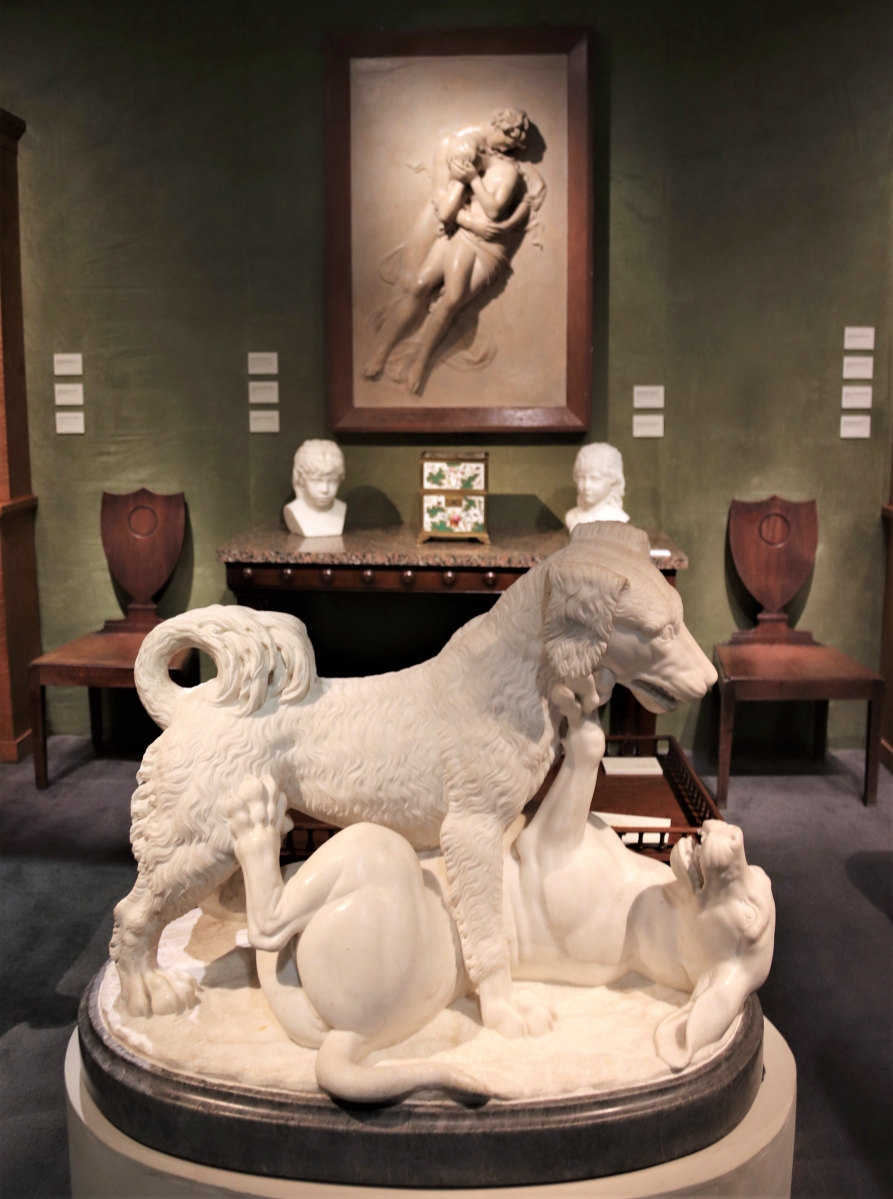
West Virginia stoneware cooler made by A.P. Donaghho & Son of Parkersburg, W.V., and advertising Harman Brothers Whiskey Merchants of Staunton, Va., left. The carved Gabriel angel is possibly from New York State and dates to about 1890. Kelly Kinzle, New Oxford, Penn.
Review and Photos by Laura Beach, Catalog Photos Courtesy The Winter Show
NEW YORK CITY – The neat symmetry of the new year, 2020, and its suggestion of perfect vision contribute to the general sense that we are at the start of a fresh era. This is nowhere truer than in the historical community, which honors the past even as it seeks to reinterpret it for a new generation. New York’s Metropolitan Museum of Art and Boston’s Museum of Fine Arts are marking their 150th anniversaries, while the Met’s American Wing and The Magazine Antiques are closing in on their centennials. Each entity concedes that the audience for American art, if not the art itself, is becoming more diverse, more global in its sensibilities, more attentive to historical complexity.
The Winter Show, led by co-chairs Lucinda Ballard and Michael Lynch and managed by executive director Helen Allen, is likewise moving forward in ways sensitive to its own 66-year legacy as a foremost barometer of American taste. “We have been responsive to changing demographics and tastes in the art market, while continuing to maintain our unyielding focus on quality,” Ballard stressed in her catalog introduction.
A benefit for East Side House Settlement, this year’s fair, which previewed at the Park Avenue Armory on Thursday, January 23, and closed ten days later, offered a subtle meditation on the past as prologue, its loan show drawn from the collections of the Hispanic Society Museum and Library. The installation signaled a theme that reverberated across the floor, from London dealer Daniel Crouch’s “Globalism,” exhibiting more than 50 terrestrial and celestial globes, to Robert Simon, the Old Masters specialist who devoted half his stand to New World Latin art. Founded in 1904 by Archer M. Huntington (1870-1955), just the sort of society figure one might expect to see shopping the Winter Show were he afoot today, the loan show suggested a broader, more inclusive American story. More directly, it also acknowledged a great institution that deserves to be better known.
Allen tweaked this year’s floor plan, engineering effective synergies. In one vivid instance, the conjunction of American Classical furniture specialist Carswell Rush Berlin, China Trade paintings and drawings expert Martyn Gregory and Chinese export porcelain dealers Cohen & Cohen created a gathering spot for enthusiasts in these allied specialties, Berlin reminding us that early Nineteenth Century American merchants who traded in Chinese wares might also have lived with his furniture. Gregory wowed with a dated 1790 oil portrait of Bostonian Samuel Blanchard by Spoilum or a member of his workshop. Cohen & Cohen featured the “Ghost flag” hong punchbowl, made for the American market around 1787-88. Happy to be back at the fair after an absence of several years, Berlin brought a Duncan Phyfe card table and cellarette.
Joan B. Mirviss installed the pop-up exhibit “Luster: Gold and Silver in Modern Japanese Ceramics.” Across the floor, S.J. Shrubsole answered with a case containing silver and mixed-metal Japonesque pieces by Tiffany & Co. Among other silver dealers, Spencer Marks quickly sold a pair of magnificent Gorham copper and silver Art Nouveau vases exhibited at the 1904 Louisiana Purchase Exposition in St Louis. New exhibitor Koopman wrote up a 1789 gold box made by Jacques Felix Vienot to honor American independence.
Several exhibitors engaged in witty, self-conscious juxtapositions of past and present. Designer Ralph Harvard’s artful recreation of the screened-in front porch of a Louisiana shotgun cottage proved a winning foil for Elle Shushan’s display of contemporary paintings by Andrew LaMar Hopkins, who renders early Nineteenth Century creole interiors and people in imaginative detail.
Macklowe paired Tiffany masterpieces with contemporary furniture by Michael Coffey, whose fluid silhouettes harmonize with earlier Art Nouveau pieces. New exhibitor Pavel Zoubok featured amusing, high-art interpretations of traditional furniture forms by contemporary makers. At Lebreton of San Francisco, Antoine Devinck’s ceramic masks evoked primitive African sculpture collected by Modernists a century before.
Marketing antiques these days requires the pairing of social media with live events. No one grasps this more fully than Michael Diaz-Griffith. Now a consultant, the Winter Show’s former associate director moderated panels at Sotheby’s and at the fair, while also co-hosting an episode of the podcast Curious Objects with young Winter Show exhibitors as participants. “Our programming, marketing and storytelling may evolve, but it’s all in service of the material we continue to love and promote. I think that is beginning to be evident even to skeptics,” Diaz-Griffith told us, adding, “My takeaway from this month is that we cannot share these perspectives too widely or often enough. There are too many people out there who don’t know what the antiques world has to offer. We’ve just got to reach them.”
Helen Allen, meanwhile, built on strategic partnerships and collaborations. “Getting people engaged helps us and other organizations build our audiences. Programs also add another level of scholarship to what we are doing,” said the executive director, who organized programs in partnership with Colnaghi Foundation, ArtTable, Asia Week New York, the Brant Foundation, the Recharge Foundation, The New York Design Center, New York Jewelry Week, Azimut Benetti and others. She added, “We’ve been videotaping several of our lectures, which we’ll then put on our website and share with our partners so the programs will be seen across different channels. We’re also live streaming a few of them, which is fun.”
Major sales take longer to consummate these days, exhibitors seem to agree. “It sometimes takes a month or two to assess results,” said Frank Levy of Bernard and S. Dean Levy, Inc, which sold a ball-and-claw foot Massachusetts Chippendale sofa, a New York card table, a pair of andirons and important pottery. This is doubly true when selling to institutions or advising on major projects, as is often the case for Barbara Israel. Midway through the fair, the antique garden ornament specialist, said, “We have quite a few irons in the fire but clients are hesitant to proceed. I’m hearing the same from top designers.”

David A. Schorsch – Eileen M. Smiles sold their folky weathervane of the Wampanoag chief King Philip (1638-1676).
By the show’s second weekend most dealers said they were pleased with results. “I think we’ve made 36 or 37 sales. Last year we did 50 to 55, but we could still make another eight to ten sales this weekend,” toy specialist Leon Weiss of Gemini Antiques, Ltd, told us.
“The fair has been extraordinarily well attended, and we’ve made sales to a variety of designers and collectors across the country,” said Martin Levy of H. Blairman & Sons, London dealers who sold furniture and works of art by designers, including Ernest Gimson, Christopher Dresser, Gordon Russell and W.A.S. Benson.
“So far I’m reasonably satisfied,” said Connecticut dealer Arthur Liverant, pleased with sales of a childhood portrait of Mattie Edwards Hewitt, later a noted photographer; a paint-decorated one drawer stand from South Paris, Maine; a California panorama painting; and a Chippendale block-front desk, the latter “already gone and delivered.”
“We ended up making about a dozen sales,” David Schorsch told us. They included a well-known sculpture of a huntsman formerly in the Alastair B. Martin collection; an 1875 Ohio farm scene on canvas by Henry Dousa; and the folky wooden weathervane “King Philip of the Wampanoag.” The Connecticut dealer observed, “We were most encouraged by the passionate interest expressed in classic early American folk art by a surprisingly wide demographic, including millennials. We spoke with hundreds of younger visitors who expressed to us a kind of annoyance at being pigeonholed and expected to only like midcentury design, which are encouraging words for those of us who love and respect beautiful old things.”
New exhibitor Taylor Thistlethwaite, who called his first time in New York “wonderful,” wrote up a bronze of a golfer, a dog weathervane mold, a Laverne low table, a carved bust of Daniel Webster and a carved Abolitionist sculpture of a snake and Uncle Sam.

At right, stylized masks by Antoine Devinck at Lebreton, San Francisco dealers in postwar French art.
“I’m happy. I’ve sold two paintings, two decorated blanket chests, some good small things and have had a ton of interest in my suite of furniture,” said Pennsylvania dealer Kelly Kinzle.
“We’ve had a great fair with a number of private and institutional sales,” London dealers Lowell Libson and Jonny Yarker noted, proud to report their sale to Mount Vernon of an 1816 portrait bust of George Washington by Massimiliano Ravenna, after a model by Giuseppe Ceracchi.
Delft specialist Aronson of Amsterdam parted with a pair of circa 1695 flower vases, sold to a private client for a six-figure amount.
Major sales at Apter-Fredericks included a pair of cassolettes by Matthew Boulton, a George III center table, and a set of four chairs by John Linnell, circa 1775.
Japanese art specialist Erik Thomsen sold “Sudden Shower and Thunderstorm,” 2017, by Yoshio Okada to a prominent New York museum and a screen to a New York collector.
A New York buyer acquired a circa 1000 BCE bull rhyton, priced in the six-figures, at Charles Ede. Another antiquities dealer, Plektron Fine Arts of Zurich, wrote up a large bronze statuette of Athena, Roman period, First Century BCE to First Century CE. It went to a private collection in the United States. At the other end of the spectrum was Michael Goedhuis’s sale of a painting by Nanjing-born artist Yang Yanping (b 1934) to a Chinese institution for what is believed to be a record price.
For additional information, www.thewintershow.org or 718-292-7392.




.jpg)
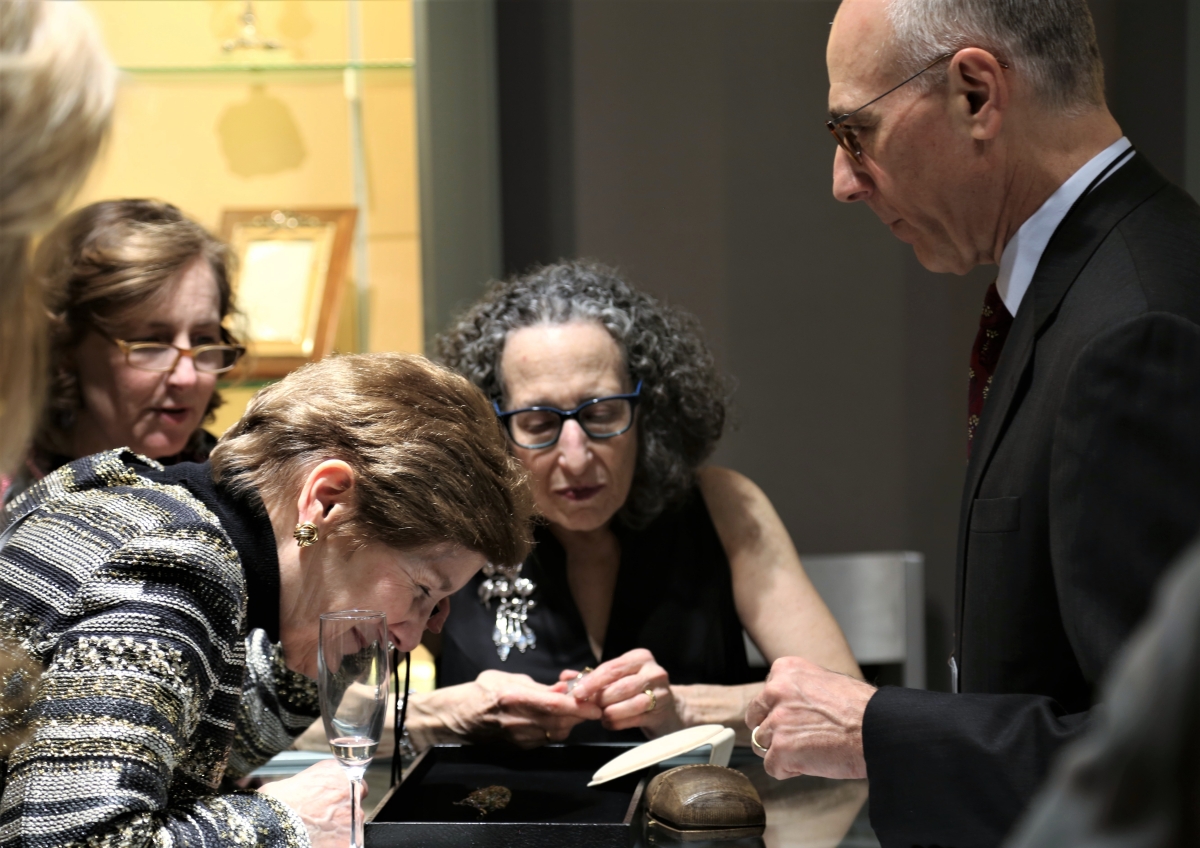
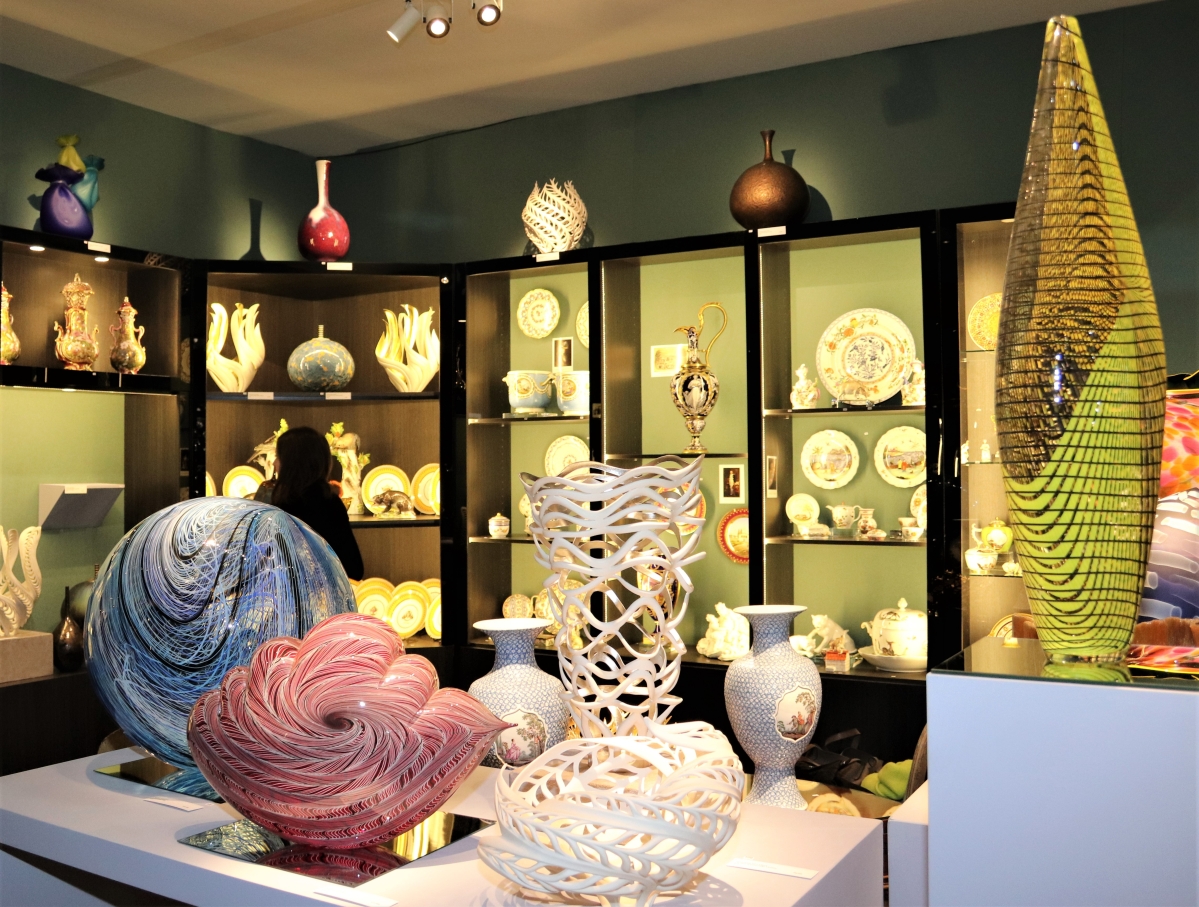
.jpg)




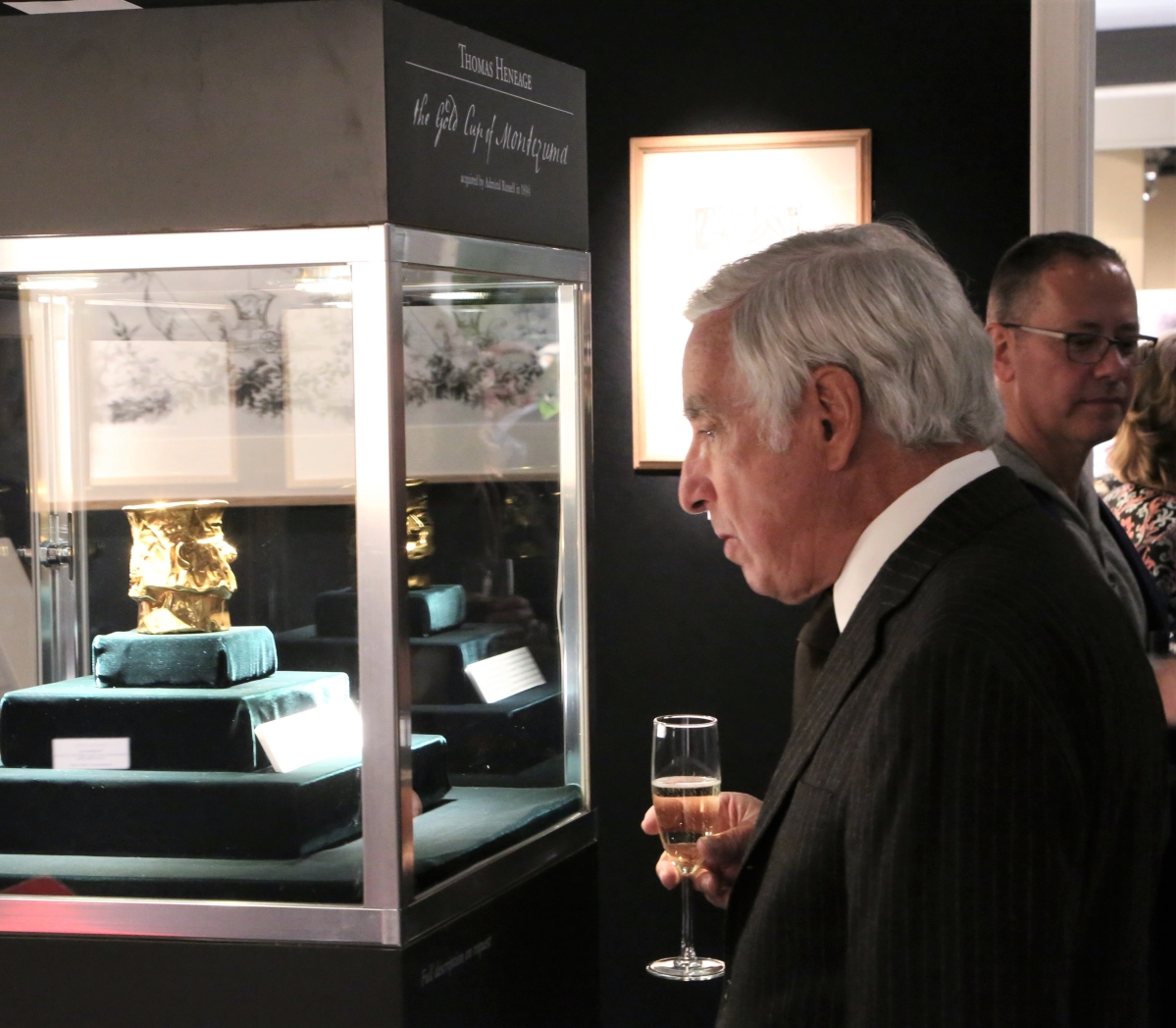



















.jpg)













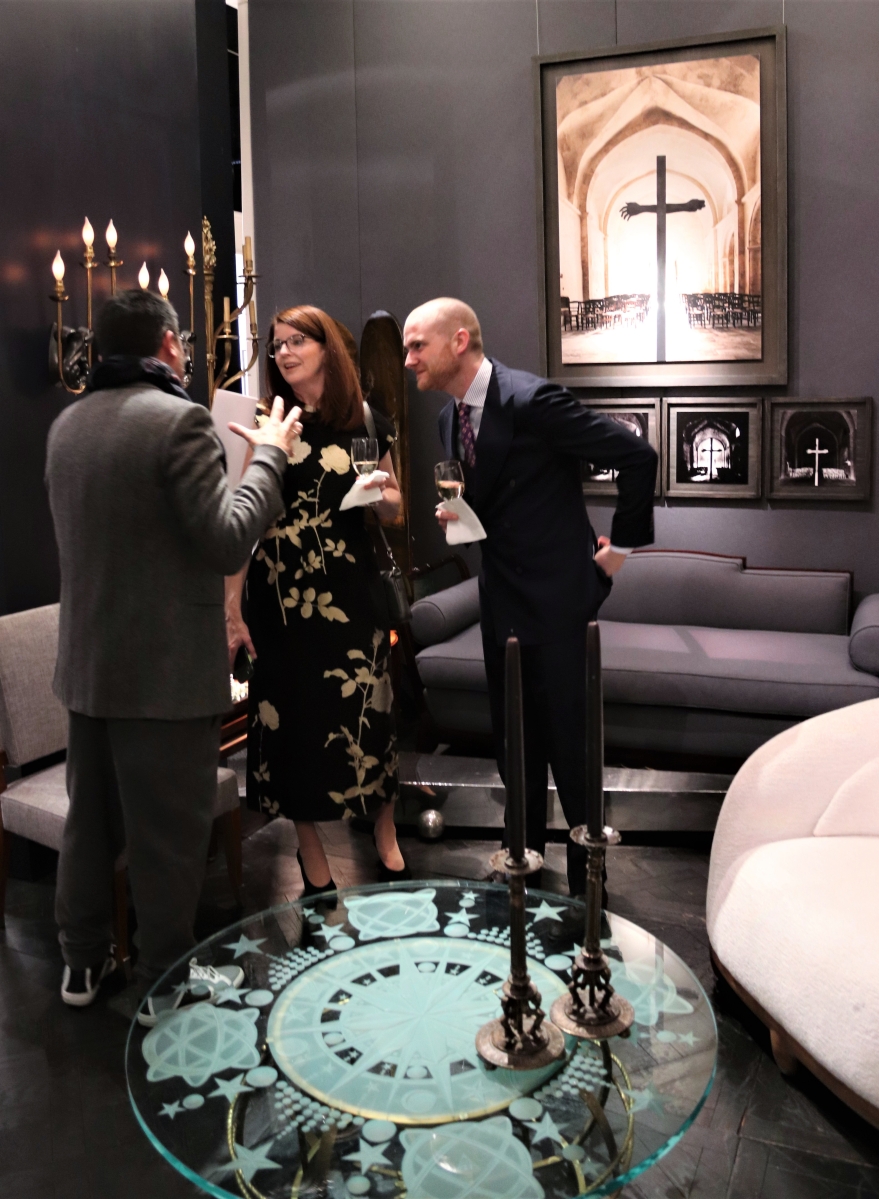


.jpg)






